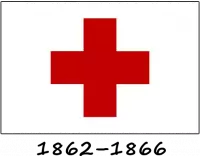The flag of Tonga was adopted on November 4, 1875 and looks like a solid red cloth with an image similar to the Swiss flag placed in the canton, i.e. a red cross on a white background, as opposed to the Swiss white cross on a red background.
The flag of Tonga was adopted on November 4, 1875 and looks like a solid red cloth with an image similar to the Swiss flag placed in the canton, i.e. a red cross on a white background, as opposed to the Swiss white cross on a red background.
The flags of Tonga, Switzerland, and Georgia have a similar design, namely, they consist of only two colors (red and white) and use only one symbol - the cross. Despite the similarities, each of them has its own unique history, cultural and symbolic meaning. The flags of Tonga and Switzerland use only one cross, while the flag of Georgia has a more complex design with five crosses. The choice of colors also reflects national identity. In Tonga, red symbolizes the blood of Christ, in Switzerland, strength and resilience, and in Georgia, red is also associated with martyrdom for the faith. The white color on all three flags stands for purity, righteousness, and peace.

In addition to the symbolic meaning, one should also pay attention to the shape of the flags, which is different. The Swiss flag is square, which makes it stand out among other national flags, while the flags of Tonga and Georgia have a traditional rectangular format, but still differ in that they have different proportions: the Swiss flag is 1:1, the Tongan flag is 1:2, and the Georgian flag is 2:3. If we talk about the typical flag format that is used most often, it is a rectangular shape with an aspect ratio of 2:3, i.e. the same as the flag of Georgia. The Swiss flag, due to its shape and connection with the Red Cross, has become a symbol of neutrality, while the flags of Tonga and Georgia, with their Christian symbols, emphasize religious and national identity.
The first Europeans to visit Tonga were the Dutch navigators Jacob Lemaire and Willem Schouten in 1616 during their voyage across the Pacific Ocean. Later, in 1643, the island was visited by another Dutch explorer, Abel Tasman, who made the first official records of the region, although contact between Europeans and locals was limited at the time. In 1773, the British explorer James Cook visited Tonga during his second expedition to the Pacific, and then again in 1774 and 1777. He named the archipelago the “Friendship Islands” because of the warm welcome he received from the locals. Thanks to European explorers such as Lemaire, Schouten, Tasman, and Cook, Tonga became known outside of Oceania, which subsequently contributed to the establishment of close contacts with the Western world and the emergence of the first state symbols.

The first king of modern Tonga is considered to be Tāufaʻahau I, who was baptized as Siaosi in honor of King George III of Great Britain. George Tupou I wanted to create a flag as a symbol of the unity of his kingdom. The centerpiece of the flag is the letters “M” (blue) and “A” (red), which are believed to symbolize King George Tupou I (his popular name is “Siaosi Taufaʻahau”). To the left of the letters are two blue crosses, and to the right are two red crosses, symbolizing Christianity and sacrifice, the struggle for faith and royalty, respectively. The flag was a symbol of the reign of King Tupou I on the main island of Tonga, Tongatapu, during the period when he tried to unite the country under a single administration, but in 1862 it was replaced.

Between 1862 and 1866, Tonga used its first official national flag, approved by King George Tupou I. The flag consisted of a red cross on a white background, where the cross symbolized Jesus Christ, the red color of his blood, and the white color of purity and peace. However, a few years later, in 1866, the flag was changed, as George Tupou I continued to adapt the state symbols to meet new needs and expectations. This was due to the consolidation of Christianity in the country, strengthening of international relations and further reforms.
The modern flag of Tonga was officially adopted on November 4, 1875 and consists of a red cloth with a white square in the upper left corner (canton), which depicts a red cross. It is important to note that in 1875, this flag was enshrined in the constitution, and according to Tonga's laws, it cannot be changed. Tonga is one of the few countries in the world where the national flag has remained unchanged for more than a century.